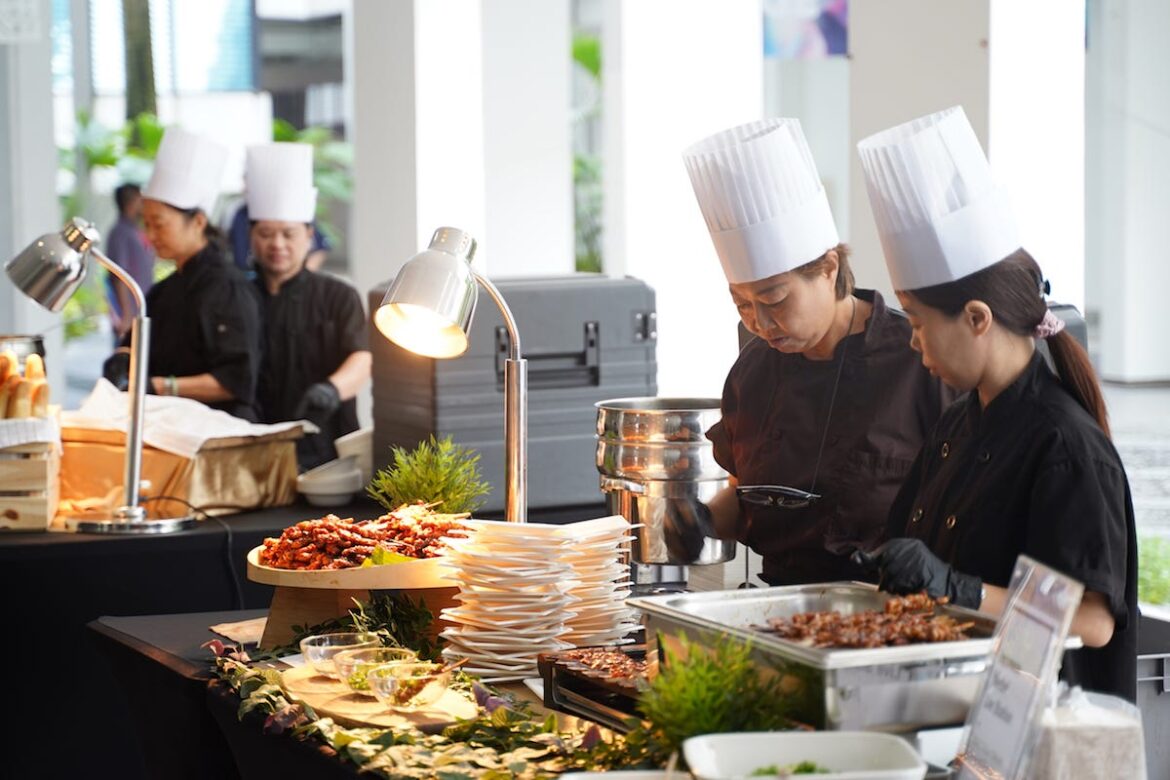Catering plays a significant role in various events, ranging from weddings and corporate gatherings to private parties and conferences.
Within the realm of catering, there are different styles and approaches that caterers employ to meet the diverse needs and preferences of their clients.
Two common forms of catering are live station catering and normal catering. While both aim to provide quality food and service, they differ significantly in their execution, presentation, and overall experience.
In this article, we will delve into each catering style, exploring their unique features, advantages, and differences.
Understanding Normal Catering
Food catering singapore, also known as traditional catering, involves the preparation and serving of food in a conventional manner.
In this setup, the food is typically prepared off-site in a kitchen facility and then transported to the event venue, where it is arranged on buffet tables or served to guests at their tables by waitstaff.
The menu selection is predetermined, and guests have limited interaction with the culinary process.
Characteristics of Normal Catering
- Predefined Menu: Normal catering usually offers a fixed menu selected in advance by the host or event organizer. This menu is often designed to accommodate a wide range of tastes and dietary preferences, ensuring that there is something for everyone.
- Pre-prepared Food: The food in normal catering is prepared ahead of time in a commercial kitchen. This allows for efficient service and ensures consistency in taste and quality.
- Buffet or Plated Service: Depending on the event, the food may be served buffet-style, where guests help themselves to the dishes on display, or plated service, where wait staff serve individual portions to guests at their tables.
- Limited Interaction: Guests have limited interaction with the chefs or kitchen staff in normal catering setups. The focus is primarily on enjoying the food and socializing with other guests.
Advantages of Normal Catering:
- Predictability: With a fixed menu and predetermined service style, normal catering offers a predictable dining experience for both hosts and guests.
- Efficiency: Preparing food off-site allows for greater efficiency in serving large groups of people, making it suitable for events with a high number of attendees.
- Cost-Effectiveness: Normal catering can often be more cost-effective than live station catering, as it requires fewer staff and less specialized equipment.
Understanding Live Station Catering
Live station catering, also known as interactive or action station catering, involves the preparation and cooking of food on-site, typically in front of guests.
This style of buffet catering singapore adds an element of entertainment and interactivity to the dining experience, as guests can observe the chefs in action and customize their dishes according to their preferences.
Characteristics of Live Station Catering
- On-Site Preparation: In live station catering, food is prepared and cooked on-site, allowing guests to witness the culinary process from start to finish.
- Customization Options: Live station catering often offers greater customization options, allowing guests to personalize their dishes by selecting ingredients, sauces, and toppings according to their taste preferences.
- Interactive Experience: The interactive nature of live station catering enhances the overall dining experience, as guests can engage with the chefs, ask questions, and learn about the ingredients and cooking techniques being used.
- Variety of Stations: Live station catering typically features multiple stations, each specializing in a different type of cuisine or cooking method. This allows guests to sample a diverse range of dishes and flavors.
Advantages of Live Station Catering
- Entertainment Value: Live station catering does add an element of entertainment and spectacle to events, creating a memorable experience for guests.
- Freshness and Quality: Because the food is prepared on-site, it is often fresher and of higher quality than pre-prepared dishes served in traditional catering setups.
- Customization: Live station catering offers guests the opportunity to customize their meals according to their preferences, catering to individual tastes and dietary requirements.
- Engagement: The interactive nature of live station catering encourages engagement and interaction among guests, fostering a lively and convivial atmosphere.
Differences between live station catering and normal catering:
- Food Preparation Process
- Normal Catering: In normal catering, the food is prepared off-site in a commercial kitchen and transported to the event venue. It is then either arranged on buffet tables or served to guests at their tables.
- Live Station Catering: Food is prepared and cooked on-site in front of the guests. Multiple cooking stations are set up, each specializing in a different type of cuisine or cooking method.
- Customization Options
- Normal Catering: Customization options are limited as the menu is predetermined. Guests typically have little to no control over the ingredients or preparation methods.
- Live Station Catering: Live station catering offers extensive customization options. Guests can interact with the chefs and personalize their dishes by selecting ingredients, sauces, and toppings according to their preferences.
- Interaction and Engagement
- Normal Catering: Interaction with the culinary staff is minimal. The focus is primarily on enjoying the food and socializing with other guests.
- Live Station Catering: Live station catering encourages interaction and engagement among guests. They can observe the chefs in action, ask questions, and learn about the ingredients and cooking techniques being used.
- Entertainment Value
- Normal Catering: Normal catering lacks the entertainment value of live station catering. The dining experience is more traditional and less interactive.
- Live Station Catering: Live station catering does add an element of entertainment and spectacle to events. Guests are entertained by watching the chefs prepare their food and can enjoy the lively atmosphere of multiple cooking stations.
- Freshness and Quality
- Normal Catering: While efforts are made to maintain freshness, the food may not be as fresh as that prepared on-site in live station catering. Quality can vary depending on factors such as transportation and storage.
- Live Station Catering: Food prepared on-site in live station catering is often fresher and of higher quality. Guests can witness the cooking process firsthand, enhancing their confidence in the freshness and quality of the dishes.
- Cost and Efficiency
- Normal Catering: Normal catering can be more cost-effective than live station catering as it requires fewer staff and less specialized equipment. It is often chosen for its efficiency in serving large groups of people.
- Live Station Catering: Live station catering may involve higher costs due to the need for additional staff, equipment, and ingredients. However, hosts may find it worth the investment for the enhanced dining experience it provides.
Conclusion
In conclusion, while both live station catering and normal catering aim to provide delicious food and impeccable service, they differ significantly in their approach and execution.
Normal catering offers a predictable and efficient dining experience, with a fixed menu and pre-prepared dishes served either buffet-style or plated.
In contrast, live station catering provides a more interactive and engaging experience, with food prepared on-site in front of guests, offering customization options and a variety of culinary stations.
Ultimately, the choice between the two catering styles depends on the preferences of the host, the nature of the event, and the desired dining experience.



